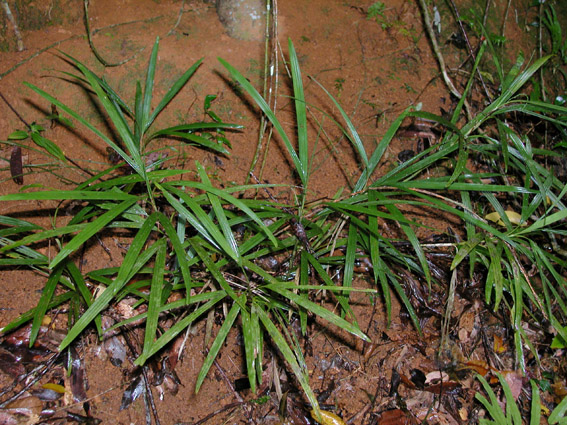- Acanthophoenix
- Acrocomia
- Actinokentia
- Actinorhytis
- Adonidia
- Aiphanes
- Allagoptera
- Ammandra
- Aphandra
- Archontophoenix
- Areca
- Arenga
- Asterogyne
- Astrocaryum
- Attalea
- Bactris
- Balaka
- Barcella
- Basselinia
- Beccariophoenix
- Bismarckia
- Borassodendron
- Borassus
- Brassiophoenix
- Burretiokentia
- Butia
- Calamus
- Calyptrocalyx
- Calyptrogyne
- Calyptronoma
- Carpentaria
- Carpoxylon
- Caryota
- Ceratolobus
- Ceroxylon
- Chamaedorea
- Chamaerops
- Chambeyronia
- Chelyocarpus
- Chuniophoenix
- Clinosperma
- Coccothrinax
- Cocos
- Corypha
- Cryosophila
- Cyphokentia
- Cyphophoenix
- Cyphosperma
- Daemonorops
- Deckenia
- Desmoncus
- Dictyocaryum
- Drymophloeus
- Elaeis
- Eleiodoxa
- Eremospatha
- Eugeissona
- Euterpe
- Gaussia
- Geonoma
- Guihaia
- Hedyscepe
- Hemithrinax
- Howea
- Hyophorbe
- Hyospathe
- Hyphaene
- Iriartea
- Iriartella
- Itaya
- Jailoloa
- Johannesteijsmannia
- Juania
- Jubaea
- Jubaeopsis
- Kentiopsis
- Kerriodoxa
- Korthalsia
- Laccospadix
- Laccosperma
- Lanonia
- Latania
- Lemurophoenix
- Leopoldinia
- Lepidocaryum
- Lepidorrhachis
- Leucothrinax
- Licuala
- Linospadix
- Livistona
- Lodoicea
- Lytocaryum
- Manicaria
- Manjekia
- Marojejya
- Masoala
- Mauritia
- Mauritiella
- Maxburretia
- Medemia
- Metroxylon
- Myrialepis
- Nannorrhops
- Nenga
- Neonicholsonia
- Neoveitchia
- Nephrosperma
- Normanbya
- Nypa
- Oenocarpus
- Oncocalamus
- Oncosperma
- Orania
- Oraniopsis
- Parajubaea
- Pelagodoxa
- Phoenicophorium
- Phoenix
- Pholidocarpus
- Pholidostachys
- Physokentia
- Phytelephas
- Pigafetta
- Pinanga
- Plectocomia
- Plectocomiopsis
- Podococcus
- Pogonotium
- Ponapea
- Prestoea
- Pseudophoenix
- Ptychococcus
- Ptychosperma
- Raphia
- Ravenea
- Reinhardtia
- Retispatha
- Rhapidophyllum
- Rhapis
- Rhopalostylis
- Roscheria
- Roystonea
- Sabal
- Sabinaria
- Salacca
- Saribus
- Satakentia
- Satranala
- Schippia
- Sclerosperma
- Socratea
- Solfia
- Sommieria
- Syagrus
- Synechanthus
- Tahina
- Tectiphiala
- Thrinax
- Trachycarpus
- Trithrinax
- Veitchia
- Verschaffeltia
- Voanioala
- Wallaceodoxa
- Wallichia
- Welfia
- Wendlandiella
- Wettinia
- Wodyetia
- Zombia
- x Jubautia splendens
- ?? Acoelorrhaphe
- ?? Bentinckia
- ?? Brahea
- ?? Clinostigma
- ?? Colpothrinax
- ?? Copernicia
- ?? Cyrtostachys
- ?? Dictyosperma
- ?? Dransfieldia
- ?? Heterospathe
- ?? Hydriastele
- ?? Iguanura
- ?? Incertae sedis & excluded names
- ?? Loxococcus
- ?? Micronoma
- ?? Paripon
- ?? Pritchardia
- ?? Rhopaloblaste
- ?? Serenoa
- ?? Washingtonia

Introduction
- This is one of the smallest palms in the world, with extremely slender stems. This is reflected in the species name, which is Latin for 'most slender'. (Dransfield, J. & Beentje, H. 1995: The Palms of Madagascar)A
Distribution
Only known from Andohahela. (Dransfield, J. & Beentje, H. 1995: The Palms of Madagascar)A
Discussion
- Distinct in the very slender stems and the tiny, thin, much-toothed leaf. (Dransfield, J. & Beentje, H. 1995: The Palms of Madagascar)A
Diagnosis
- Caulibus gracillimis folio minuto tenue multo lobato distincta. (Dransfield, J. & Beentje, H. 1995: The Palms of Madagascar)A
Biology And Ecology
- Lowland rain forest, slight mid slope; 500-550 m. (Dransfield, J. & Beentje, H. 1995: The Palms of Madagascar)A
Conservation
- Endangered. Only known from a single site; numbers seen were less than a hundred. This area is outside the protected area. (Dransfield, J. & Beentje, H. 1995: The Palms of Madagascar)A
Common Name
- Not recorded. (Dransfield, J. & Beentje, H. 1995: The Palms of Madagascar)A
Uses
- Not recorded. (Dransfield, J. & Beentje, H. 1995: The Palms of Madagascar)A
Description
- Clustering palm in groups of 2-6. STEMS 25-50 cm high, 2-4 mm diam.; internodes 1-4 cm. LEAVES 4-11 in the crown, entire or pinnate; sheath 2.3-6 cm, closed, with sloping, slightly laciniate shoulders and with scattered scales; petiole 2-4.6 cm, 1-1.5 mm diam., with scattered scales; entire leaves 11-19 cm long, midrib 1.7-4.5 cm, the lobes 8-15 x 0.7-1.3 cm (lobed 75-85 %), with 3-5 main veins, narrowly dentate apices, glabrous or with a few proximal scales; pinnate leaves with rachis 4.5-6 cm long, with scattered scales; leaflets 2-5 on each side of the rachis, the proximal 9-14 x 0.3-0.6 cm (main veins 1-2), median 9-13 x 0.3-4 cm (interval 0.8-1.2 cm, main vein 1), apices attenuate, distal 11-14 x 0.5-1 cm, connate for 3-4 cm, with 2-3 main veins and narrow dentate apices, glabrous. INFLORESCENCE interfoliar, unbranched, 9-16 cm long; peduncle 6-11 cm long, c. 1 mm diam.; prophyll 6-9 cm long, borne at 2.5-4 cm above the base of the peduncle, with few scattered scales especially on the margins (resembling thin ramenta), open at the apex for 0.6-1 cm; peduncular bract inserted at 6-9 cm from the base of the peduncle, deciduous; non-tubular peduncular bract 1-2 mm; rachilla 3.2-4.3 cm long, 1-2 mm diam., with distant triads, glabrous. STAMINATE FLOWERS with sepals 0.7-1 x 0.6-1.1 mm, only slightly keeled; petals 2.2-2.5 x 1.2-1.4 mm; stamens 6, uniseriate, filaments c. 0.8 mm and thin, anthers 1.1-1.3 x 0.3-0.5 mm, versatile and parallel; pistillode < 1 mm. PISTILLATE FLOWERS with sepals 0.8-1.2 x 1.2-1.4 mm; petals 1.8-2.3 x 1.7-2.2 mm; staminodes 0.3-0.7 mm; ovary 2.1-2.4 x 1.8-2 mm. FRUIT ellipsoid, 9.5-10 x 5-5.5 mm, rounded at the apex; endocarp with almost free fibres. SEED ellipsoid, 8-9 x 3.5 mm, obtuse at both ends; endosperm homogeneous. (Dransfield, J. & Beentje, H. 1995: The Palms of Madagascar)A
Materials Examined
- Tolanaro: 13 km N of Ezoambo, March 1992 (fl., y.fr.), Beentje & Andriampaniry 4592 (Holotype K; isotypes BH, MO, P, TAN); idem, March 1992 (ster.), Beentje & Andriampaniry 4601 (K). (Dransfield, J. & Beentje, H. 1995: The Palms of Madagascar)A
- Log in to post comments

